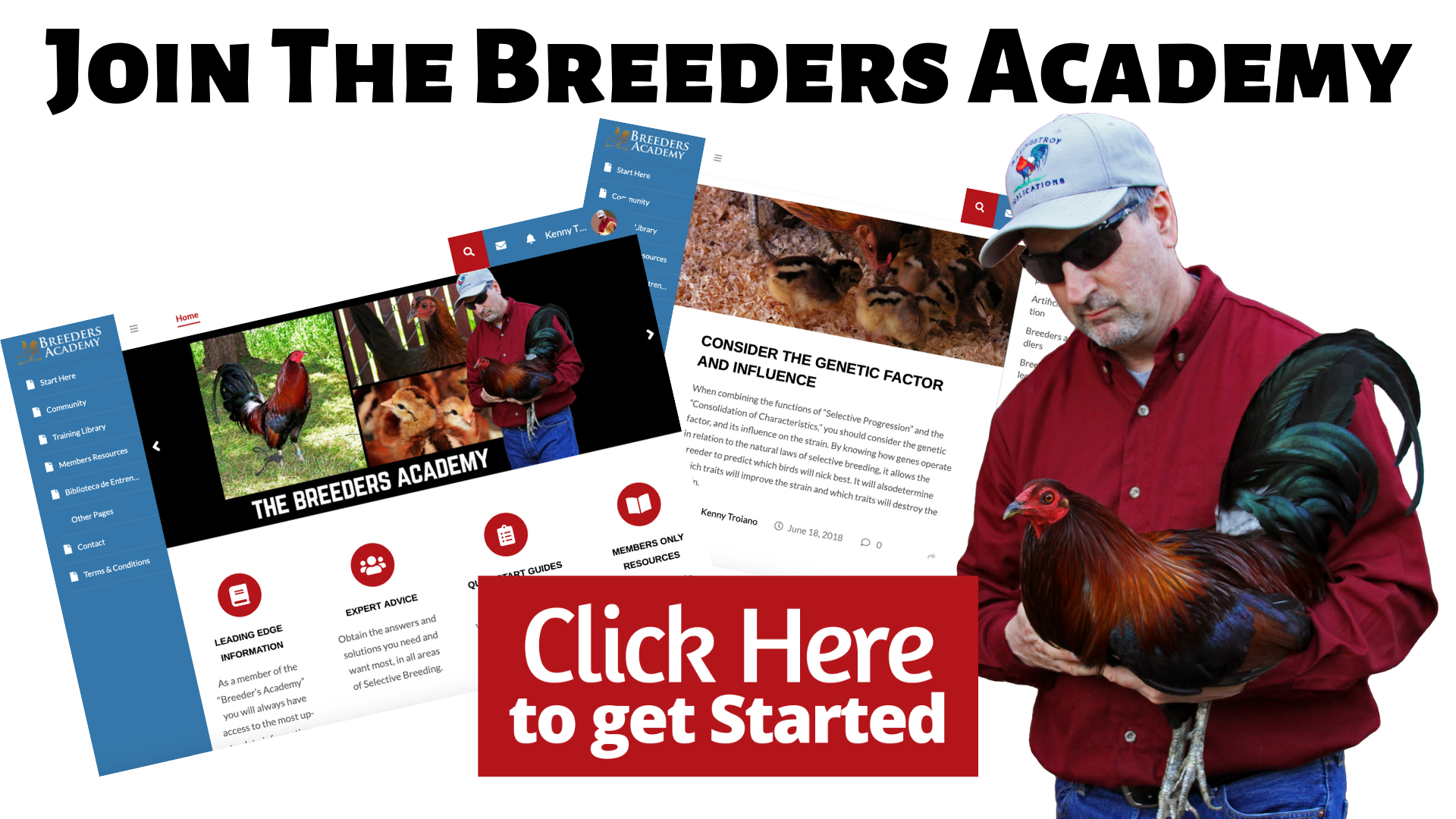The hardiest and most adaptable, they are the easiest fowl to raise
By Kenny Troiano
Copyright © 2019 by Kenny Troiano/Maximus Troy Publications
We covered this subject a little bit in previous pages. However, I would like to elaborate on this a bit more. The reason being is that there are some who are interested in chickens, fascinated with American Games, yet they are wondering if American Games are the right fowl for them. This will demonstrate how easy American Games are to keep and raise, and will illustrate many of their great attributes.
To begin with, let’s look at the contrast between fowl. For instance, there are some fowl that are high maintenance, while others that are self-sufficient. Some are fragile, while others are hardy and robust. Some fowl need a great deal of human intervention, while others are very easy to raise, in fact, they almost raise themselves.
Then there is the matter of their overall purpose. In this case, some are great layers but are poor meat producers, while others are great in the meat department but are poor layers. The modern day farmer specializes in one breed or the other (eggs or meat), seldom both. For instance, Leghorns are good at only one thing, laying eggs; they have very little meat on their bones. The problem is, when it comes to specialty breeds, ones bred for a single purpose, in the process of perfecting their form and function, for the purpose for which they are bred for, other traits are inadvertently bred out. As a result, they become more and more dependent on human intervention to survive.
American Games have many possibilities:American Games are somewhat sufficient in all forms and purposes. They are decent layers and have more meat on their bones than most egg laying breeds. Having a wide variety of beautiful plumage colors, they are also great show birds. They are full of personality and have many of the natural instinct of their wild ancestor. And, let’s face it, they are fun to keep and raise.
American Games are also strong, vigorous fowl that can endure the harshest of environments. For instance, they are extremely hardy and they adapt very well to new environments. No matter what the conditions may be they generally do well. In fact, they are the hardiest and most self-reliant breed that we have today. You could put a small flock of American Games on a hill, free from human intervention, and they would not only survive, but they would thrive. Being the closest fowl to that of the Wild Junglefowl, they have retained all the instincts of their wild ancestors. They have everything they need to survive and multiply, even under the harshest of conditions.
Artificial Selection and its effect on survivability:Chickens, such as those raised for commercial purposes, and many of the general purpose and ornamental breeds that have been kept in confinement for generations, are normally less self-reliant than those that are exposed to the elements of Mother Nature. If exposed to the effects of Natural Selection many of our domestic fowl would quickly die off and become extinct. This is due to the effects of Artificial Selection, where most of their natural instincts, especially those that have to do with survivability, have been lost. Traits such as broodiness and forageability have been bred-out in favor of higher production and feed efficiency.
Artificial Selection and American Games:Although Artificial Selection has been detrimental to the survivability of most fowl, American Games continue to evolve, and they have done so in very beneficial ways. Through the process of artificial selection, breeders of American Games have improved their overall form and function (conformation of body and color of plumage, as well as their temperament and gameness), and have retained their survivability. I will talk about this a bit more in a moment, but it’s important to recognize that breeders of American Games do something that may be even more significant, they free-ranged their fowl. This has allowed Mother Nature to play in important role in the selection and progression of the breed, and to improve their form and function for the future.
The process that made American Games the hardiest and most adaptable fowl:The process that has helped maintained their hardiness and adaptability, is the practice of free-ranging. There are many benefits to free-ranging your fowl and exposing them to the elements of Mother Nature. And one very important benefit is that of survival of the fittest. Mother Nature and the process of Natural Selection will cull the weak and deformed, and preserve the individuals that are fit. In cases such as these, Natural Selection continues to improve the breed. The birds that are able to adapt to their environment, survive, while the rest die of disease or are eaten by predators.
When it comes to American Games, stags and pullets are usually free-ranged until they are a good five months of age. They begin the process at an early age, sometimes as chicks with their mother who acts as caretaker and teacher. If not being used in the brood-pen, cocks are string walked, while the hens are allowed to run free. Free-ranging hens, especially in the offseason, allows the hens to recover from the long breeding season, and the rigorous climate of summer.
In some cases, even the cock is free-ranged:On a good “farm walk” (a type of free-ranging), a cock is free-ranged, and allowed to guard and care for his harem of hens. He gets good exercise, and uses his foraging and survival instincts, and is exposed to the elements of Mother Nature. It is my experience that the best cocks come from breeders that “farm walk” their cocks.
American Games have an advantage over other fowl:As the closest living relative to the ancient Wild Junglefowl, American Games have an advantage over other fowl, and that is they are easy to raise. Although they are neither plump, nor productive as the commercial or general-purpose breeds, they compensate by being almost entirely maintenance free. They are hardy and extremely resilient. They also have characteristics and traits that increase their survivability.
Characteristics that improve a bird’s survivability are its:
- Color of Plumage,
- Type of Plumage,
- Conformation of Body
- Ability to Fly and Avoid Predators,
- Foraging Ability,
- Brooding Instincts
- A Strong Constitutional Vigor
- And Strong Resistance to Most Diseases
The feather color of most American Games gives them the power to blend more easily into their surroundings than most domestic fowl. They have, what is called cryptic coloration, whereas, most domestic fowl are either white or black, with a few colors in-between. This cryptic coloration offers American Games plenty of protection from predators.
The type of plumage they have works like body armor. It protects them from the elements (sun, rain, hot and cold), predators, and when defending their territory.
American Games also have an athletic structure like no other. Their conformation of body gives them amazing speed and agility, and wings that allow them to fly far and high to escape predators. The wings also help them to fly up high into trees to roost.
American Games have also retained their instincts to forage for food, and to brood (hatch and raise) their chicks, which require no intervention by us to reproduce, compared to their commercial cousins whose brooding instincts have been bred out of them. For these breeds, the incubator and brooder are necessities for their survival and continued existence.
And, most importantly, American Games have a strong constitutional vigor, and are resistant to most diseases. They rarely get sick, and when they do, they recover fairly quickly.
American Games have very little that hinders their survivability. However, if there are any weaknesses, this is what they could be.
Characteristics that could hinder their survivability:
- White Eggs
- Crowing and Cackling
- Varieties with Light Colored Plumages.
Although minor in their importance, these are issues that could plague the breed’s survivability. For example, white eggs are easier for predators to locate. Hens that have smart nesting instincts are usually successful.
Sounds tend to expose them to predators. For example, crowing marks their territory, and cackling is meant to distract predators, but these noises tend to give up their position.
Some varieties of American Games have white or light colored plumages; these varieties stand out like big white flags. It is for this reason that predators usually attack these fowl first. Natural Selection would most likely eliminate these varieties.
In short, American Games have retained most of their wild instincts, and are more capable of living on their own, free of human involvement than most domestic fowl. As I mentioned earlier, if left to survive without any human intervention, I’m convinced that American Games would do just fine. They would not only survive but they would thrive. They would procreate and populate a whole countryside before you knew what was going on. Mother Nature, through the process of Natural Selection, would progress the breed. As time passed they would become stronger, more adaptable to their surroundings. Some say they would even evolve, becoming a new species.
If you are looking for fowl that are easy to raise and breed, that are full of personality, and are hardy and resistant to most diseases, then American Games are the right fowl for you.
I hope you enjoyed the article, and that the information which I provide helps you in the eventual improvement and advancement of your fowl. It is a long journey, but a worthwhile one. Remember, if we all work harder to perpetuate superior fowl, fowl that have the complete package (appearance, temperament and performance), everyone benefits. Hope you have a great fall. Cooler weather is on the way!
Sincerely, Kenny Troiano


